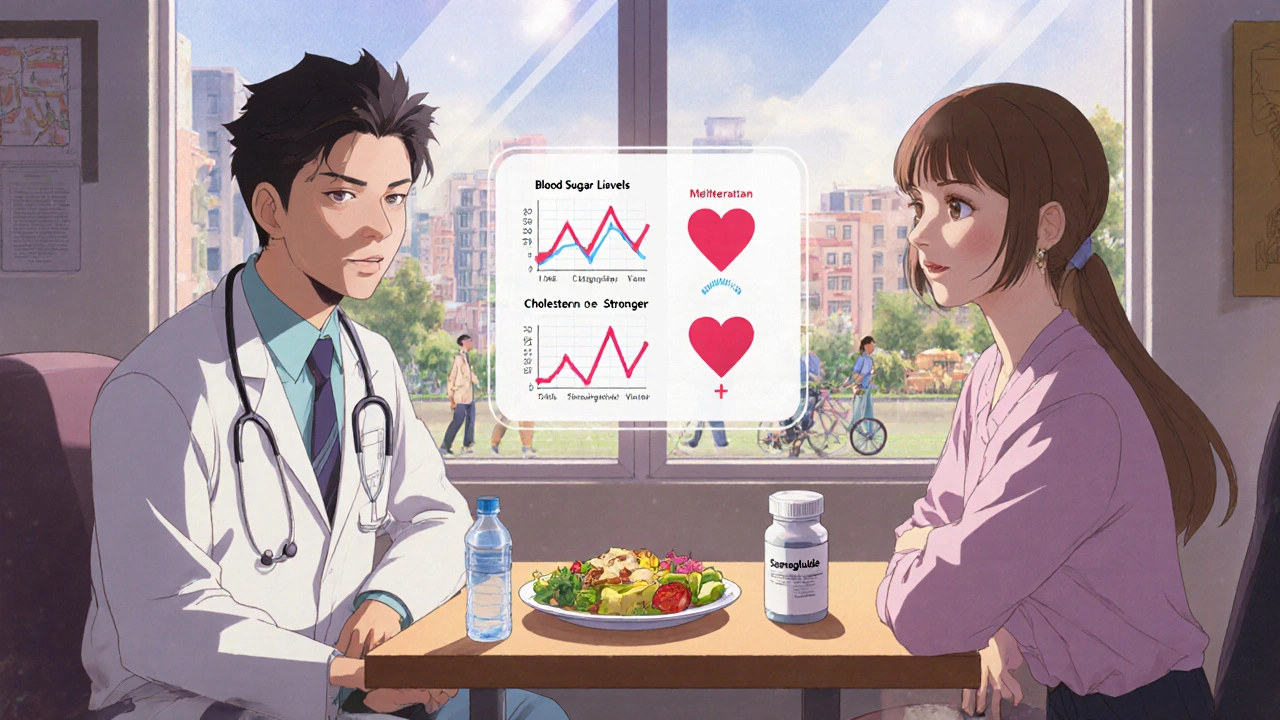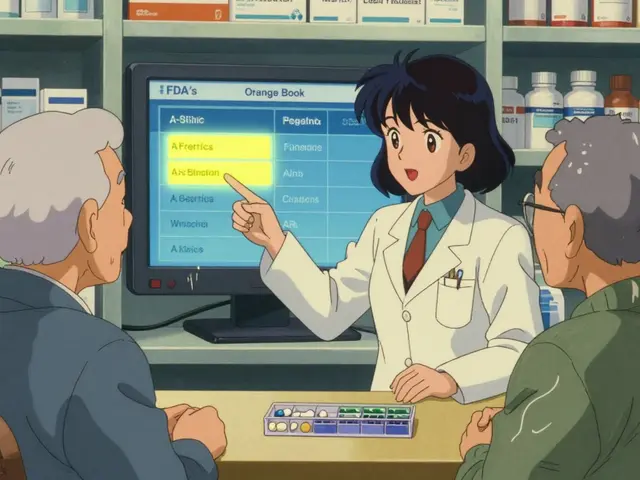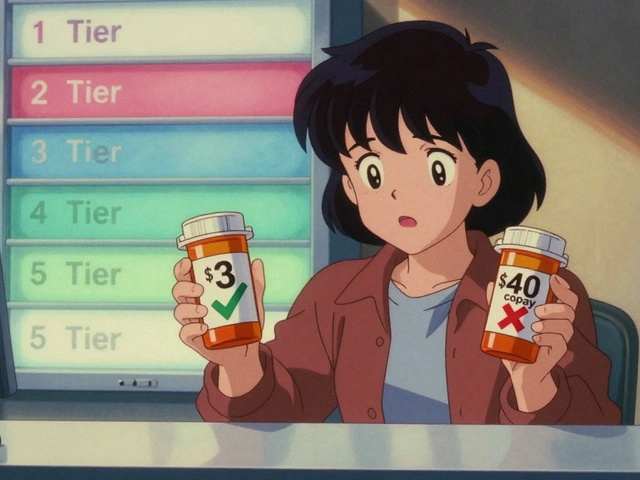
If you have type 2 diabetes, your risk of heart disease isn’t just higher-it’s the leading cause of death. About 65% of people with diabetes die from cardiovascular problems, according to the American Heart Association. That’s not a distant threat. It’s the reality for millions. But here’s the good news: you don’t have to accept that fate. Combining modern medications with real, sustainable lifestyle changes can cut your risk of heart attack, stroke, and death by more than half. This isn’t theory. It’s proven science-and it’s happening right now in clinics across North America.
Why Diabetes and Heart Disease Are Linked
Diabetes doesn’t just mean high blood sugar. It means your whole body is under stress. High glucose levels damage blood vessels over time. They make arteries stiff, promote inflammation, and encourage plaque buildup. At the same time, many people with type 2 diabetes also have high blood pressure, abnormal cholesterol, and excess weight-all of which push the heart toward failure. The 2017 ACC/AHA guidelines made it official: diabetes is a cardiovascular risk equivalent. That means if you have diabetes, your heart is as vulnerable as someone who’s already had a heart attack.
For years, doctors treated this as two separate problems: manage blood sugar first, then worry about the heart. But that approach missed the point. The root issue isn’t just glucose-it’s metabolic dysfunction. And that’s where new medications are changing everything.
How GLP-1 RAs Are Rewriting the Rules
Medications like semaglutide (Wegovy, Ozempic) and tirzepatide (Mounjaro, Zepbound) aren’t just for weight loss. They’re now FDA-approved to directly reduce heart risk in people with diabetes and obesity. These drugs work by mimicking natural gut hormones that help your body control blood sugar and appetite. They slow digestion, reduce hunger, and make your pancreas release insulin only when needed-no spikes, no crashes.
The numbers speak for themselves. In the STEP 1 trial, people using semaglutide lost nearly 15% of their body weight on average. Tirzepatide pushed that to over 22% in the SURMOUNT-1 study. But weight loss is just one part. These drugs also lower blood pressure, reduce inflammation, and improve cholesterol-all independently tied to fewer heart events.
The LEADER trial showed liraglutide (another GLP-1 RA) cut major heart events by 13% compared to placebo. But the real breakthrough came in 2023, when the FDA approved Wegovy specifically to reduce heart attack, stroke, and cardiovascular death in adults with obesity or overweight and existing heart disease. This was the first time a weight-loss drug got this kind of approval. It’s not an add-on. It’s a core treatment.
What Lifestyle Changes Actually Work
Medications are powerful, but they’re not magic. The FDA requires Wegovy to be used “in addition to a reduced calorie diet and increased physical activity.” That’s not a footnote-it’s the key. Lifestyle changes don’t just support medication; they multiply its effect.
The American Diabetes Association doesn’t push one diet. Instead, they recommend proven patterns: Mediterranean, DASH, or plant-based eating. What these all have in common? They’re rich in vegetables, whole grains, beans, nuts, and healthy fats-and low in processed carbs and added sugars. You don’t need to go keto or vegan. Just cut out the packaged snacks, sugary drinks, and white bread. Swap them for real food.
Exercise doesn’t have to mean running marathons. The CDC and ADA agree: aim for 150 minutes of moderate activity a week. That’s 30 minutes, five days a week. Break it into 10-minute walks if that’s easier. Walking after dinner, taking the stairs, gardening-these count. Studies show exercise reduces heart disease mortality by 27% in people recovering from cardiac events. That’s as strong as many medications.
Other habits matter too. Sleep seven to eight hours a night. Don’t smoke. Limit alcohol. Manage stress. Loneliness and chronic stress raise cortisol, which spikes blood sugar and blood pressure. Building real connections-with family, friends, or support groups-can be as protective as a statin.

The Synergy: When Medication Meets Lifestyle
Here’s what no one talks about enough: combining GLP-1 RAs with healthy habits doesn’t just add up-it multiplies.
A study from the VA Boston Healthcare System tracked veterans with type 2 diabetes. Those taking GLP-1 RAs alone had a 20% lower risk of major heart events. But those who also followed eight heart-healthy habits-eating well, exercising, sleeping right, not smoking, managing stress, limiting alcohol, maintaining social ties, and keeping a healthy weight-cut their risk by 63%. That’s not 20% plus 43%. That’s a compound effect. Each healthy habit built on the last.
Why? Because medication targets biology. Lifestyle targets behavior. GLP-1 RAs reduce hunger and improve metabolism. But if you’re still eating fast food every night, the drug can’t overcome that. If you’re sedentary, the weight loss won’t stick. If you’re stressed and sleep-deprived, your body fights the medication’s effects.
Think of it like this: medication gives you the tools. Lifestyle gives you the skill to use them.
What About Metformin? Is It Still Enough?
Metformin has been the go-to for decades. It’s cheap, safe, and helps with blood sugar. But when it comes to heart protection, it’s not the strongest tool anymore. While metformin offers modest cardiovascular benefits, GLP-1 RAs have consistently outperformed it in head-to-head trials. The ACC’s June 2025 guidance now says these newer drugs are “more effective than lifestyle interventions at not only weight loss, but at reducing overall cardiovascular disease risk.”
That doesn’t mean ditch lifestyle. It means you don’t have to wait. In the past, doctors made patients try diet and exercise for six months before prescribing anything stronger. That’s outdated. Obesity is a chronic disease. You wouldn’t wait six months to treat high blood pressure. Don’t wait to treat obesity-related heart risk either.
Now, the advice is clear: if you have type 2 diabetes and excess weight, talk to your doctor about GLP-1 RAs-right away. But don’t wait for the prescription to start changing your habits. Do both at the same time.

Real Barriers-and How to Overcome Them
These treatments aren’t perfect. Cost and access are huge issues. Insurance often denies coverage for Wegovy or Mounjaro unless you’ve tried other drugs first. Even with coverage, out-of-pocket costs can hit $1,000 a month. That’s why only about 2% of eligible patients are on these medications.
But there are ways forward. Ask your doctor about patient assistance programs from Novo Nordisk or Eli Lilly. Some pharmacies offer discount cards. Community health centers may have sliding-scale programs. And if you can’t get the medication yet, focus on the lifestyle pieces. Even small changes-like swapping soda for water, walking 15 minutes after meals, or getting 30 minutes more sleep a night-can lower your risk.
Also, don’t let perfection stop you. You don’t need to eat perfectly or exercise every single day. Progress, not perfection, is what matters. One study showed that adopting just three healthy habits reduced heart risk by 40%. Start with one. Then add another.
The Future Is Integrated
The field is moving fast. Researchers are now testing combinations of GLP-1 RAs with other drugs that target fat metabolism, inflammation, and insulin sensitivity. Tirzepatide, which acts on two hormones (GIP and GLP-1), is already showing stronger results than single-action drugs. Future treatments may be tailored to your genes, your metabolism, even your gut bacteria.
But no matter how advanced the drugs get, the core message stays the same: you’re not powerless. Diabetes and heart disease aren’t inevitable. With the right tools-medication that works and habits that last-you can take back control. The science is clear. The tools are here. What you do next matters more than ever.
Can I reduce my heart disease risk if I have diabetes but don’t need to lose weight?
Yes. Even if you’re at a healthy weight, type 2 diabetes still increases your heart disease risk. GLP-1 receptor agonists like Ozempic and Mounjaro help control blood sugar and reduce inflammation regardless of weight. Studies show they lower heart attack and stroke risk even in people without obesity. Lifestyle changes-like eating more vegetables, walking daily, and managing stress-also help protect your heart directly, even without weight loss.
How long does it take to see heart benefits from GLP-1 RAs?
Some improvements, like lower blood pressure and better cholesterol, can show up within weeks. But the biggest heart protection comes from long-term use. Clinical trials like SELECT and LEADER tracked patients for 3 to 5 years and saw the strongest reduction in heart events after sustained use. The benefit builds over time, so staying on the medication and keeping up with healthy habits matters more than quick results.
Are GLP-1 RAs safe for long-term use?
Yes. GLP-1 RAs like semaglutide and tirzepatide have been studied in tens of thousands of patients over several years. The most common side effects are mild nausea or digestive upset, especially when starting. These usually fade within a few weeks. Serious risks like pancreatitis or gallbladder disease are rare. The FDA and leading heart organizations agree the benefits far outweigh the risks for people with diabetes and heart disease risk factors.
Can I stop taking my heart medications if I start a GLP-1 RA?
No. GLP-1 RAs are not replacements for blood pressure pills, statins, or aspirin if your doctor prescribed them. They work alongside these medications to give you better overall protection. Stopping your prescribed heart meds without medical advice can be dangerous. Always talk to your doctor before making any changes to your regimen.
What if I can’t afford GLP-1 RA medications?
You still have options. Focus on the lifestyle factors that have the biggest impact: eating whole foods, moving daily, sleeping well, and not smoking. Even without medication, adopting just three healthy habits can cut your heart risk by 40%. Many community health centers offer free nutrition counseling and exercise programs. Ask your doctor about patient assistance programs from drugmakers-many offer free or low-cost access for those who qualify.





11 Comments
lol so now we're supposed to believe a weight loss drug is a heart cure? 🤡 next they'll say soda is healthy if you take ozempic. i've seen people on this stuff throw up daily and still eat junk. it's not magic, it's just a fancy appetite suppressant. the real fix? stop eating like a raccoon. 🤷♂️
this is actually really helpful. i was scared to even talk to my doc about meds, but hearing that lifestyle + meds together can cut risk by over half? that gives me hope. i started walking after dinner last week and already feel less bloated. small steps, right? 💪
i'm curious-how do GLP-1 RAs actually reduce inflammation? the post mentions it but doesn't explain the mechanism. is it just from weight loss, or is there a direct effect on cytokines? i read something about adipose tissue signaling but i'm not sure.
The claim that GLP-1 RAs reduce heart events by 13% in the LEADER trial is misleading. That’s a relative risk reduction. Absolute risk reduction was 2.1%. And the cost? $1,000/month. For many, that’s not ‘core treatment’-it’s a luxury. Don’t confuse statistical significance with real-world accessibility. The data is solid. The system? Broken.
It is imperative to recognize that the integration of pharmacological intervention with behavioral modification constitutes a paradigm shift in the clinical management of type 2 diabetes and its associated cardiovascular comorbidities. The confluence of metabolic, physiological, and psychological domains necessitates a holistic, multidisciplinary approach-one that transcends the antiquated notion of treating hyperglycemia as an isolated pathology. The evidence presented here, particularly the VA Boston study, demonstrates that synergistic outcomes are not merely additive, but multiplicative, suggesting that the whole is demonstrably greater than the sum of its parts. This is not merely medical advice; it is a call to reframe our understanding of chronic disease as a dynamic interplay between biology and behavior.
they're all just selling you drugs. big pharma doesn't care if you live or die, they care if you're hooked on $1000/month injections. and don't even get me started on how they market this as 'empowerment' when most people can't afford it. it's a scam wrapped in science. 😭
To the person who said this is a scam: you're not wrong about access, but dismissing the science because it’s expensive is dangerous. GLP-1 RAs are proven to save lives. The problem isn't the medicine-it's the system denying it. If you can't afford it, advocate. Call your reps. Use patient assistance programs. But don’t let corporate greed make you reject life-saving tools. You deserve better than fear-mongering.
i think the real thing no one talks about is how lonely this journey is. i’ve been on metformin for 8 years, tried every diet, felt guilty every time i ate bread… then i started walking with my neighbor every morning. we don’t even talk about diabetes. we just talk about our cats and bad TV. and somehow, my numbers got better. maybe it’s not just the food or the meds. maybe it’s just not being alone. 🌱
so wait, if i dont need to lose weight, do i still need the drug? or just the veggies and walks?
i read this whole thing and cried a little. not because i’m scared, but because for the first time, someone made me feel like my health isn’t a failure. i’ve been told i’m lazy for not losing weight. but what if i just need the right tools? not guilt. not shame. just a real plan. thank you for writing this. i’m calling my doctor tomorrow.
In India, we face a different reality. Many people here have type 2 diabetes and heart disease but cannot even afford metformin, let alone GLP-1 RAs. Yet, traditional diets-like lentils, millet, turmeric, and daily walking after dinner-are still widely practiced. I’ve seen elders in my village, 70+ years old, with no meds, no gym, no fancy supplements, yet their blood pressure and sugar are better than my city friends on expensive drugs. The science is great, but let’s not forget that human resilience and simple, ancestral habits have always been powerful. Maybe the answer isn’t just new drugs-it’s remembering what worked before we overcomplicated everything.